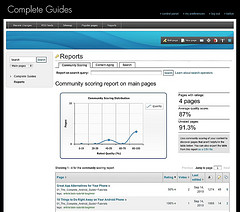 I recently got the chance to try out MindTouch Core by installing it on my Windows Vista machine. photo credit: Roebot
I recently got the chance to try out MindTouch Core by installing it on my Windows Vista machine. photo credit: Roebot
In case you haven’t heard of MindTouch Core (formerly known as Deki Wiki), it’s basically a free and open source collaboration platform which is ranked as one of the top open source projects in the world.
MindTouch Core is implemented by many organizations for the following key purposes:
- Team sites
- Social intranet
- Enterprise wiki
- Knowledge base
- Documentation development
- Enterprise collaboration platform
MindTouch is available in three editions namely:
- Software download (self hosted)
- Shared cloud (10 – 50 users)
- Dedicated cloud (50 – unlimited users)
To install it on premise, there are installers available for Windows and Linux operating systems and a prebuilt VMWare virtual machine is also available for download.
If you would like to quickly evaluate MindTouch, I would recommend the free 30 days trial of MindTouch Cloud where you can gain access after filling in the required details. The only drawback to this approach is the required billing details where you’ll be charged after 30 days.
For those who prefer not to enter billing details, just download the universal installer and install MindTouch on your machine.
I downloaded the MindTouch Installer (about 87MB) and installed it on my Windows Vista without any problems.
Once installed, MindTouch will send you a license key for product activation purposes after which you should be able to try out MindTouch Core.
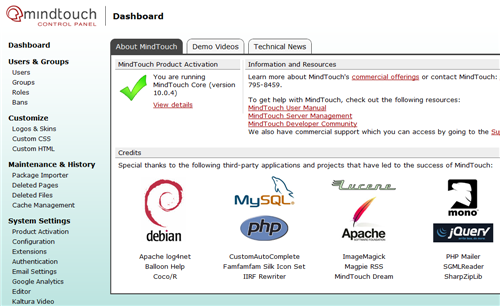
Initially, you’ll be logged in as the administrator of MindTouch Core and shown the control panel where you can create groups, add roles, users and even customize the open source collaboration tool.
I was more interested to find out how the system would look like for users, so what I did was create a user called Bob and signed in as Bob.
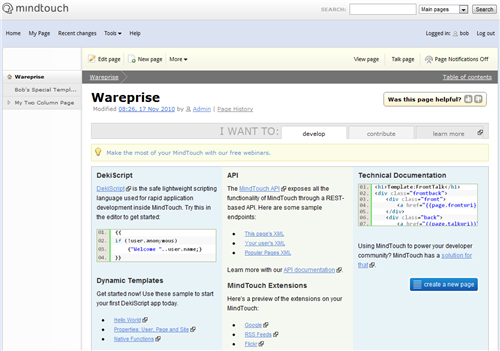
From the user’s screen, thing got a lot more clearer to me as I could see the various features and capability of MindTouch Core.
My first thought about MindTouch is that this system is very Wiki like whereby people can easily add new content and share information.
After learning a little more about MindTouch, I found out that contributers and administrators can spice up the collaboration platform further by adding in apps, templates and extensions which can be easily added via the control panel.
Currently, the app catalog has 149 entries for contributers / developers to work on and integrate into their system. Some of the apps include:
- Task List
- Simple Blog
- Bug & Issue Tracker
- AJAX Twitter Widget
- AJAX Discussion Forum
- and more…
Although I didn’t get a chance to successfully add an app into my system, I managed to add in new content / pages and this is how it went.
Clicking on a new page, I get to select a page template.
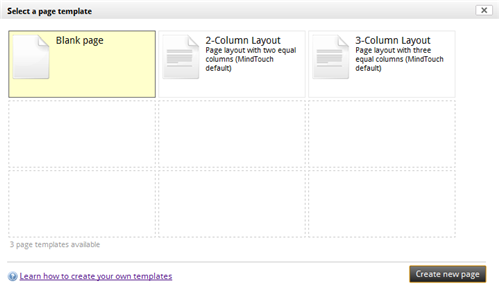
Click on the Create new page button and you can add content via the WYSIWYG editor.
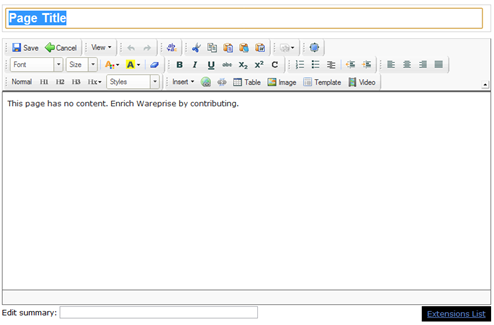
Once the information has been added, this particular page will be added into the system and you should be able to access it from your left side bar.
All pages allow comments to be added to encourage user collaboration and discussions.
Another cool feature is the page notifications where by users can subscribe to receive email notifications whenever a page has been updated with new information.
The only downside that I noticed is missing within MindTouch is document management and workflow. I’ve searched in within the apps catalog but couldn’t find any. But I guess it won’t be long before someone develop and add it into the apps catalog.
Other than that, I believe MindTouch Core is still a good tool for organization employees to share and work together on developing all sorts of content / documentations such as user guides, manuals, lists, proposals, templates and so on.
To learn more about MindTouch products, I would recommend checking out out their demo videos or simply download MindTouch Core and give it a try today!


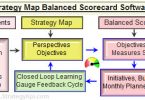


Leave a Comment